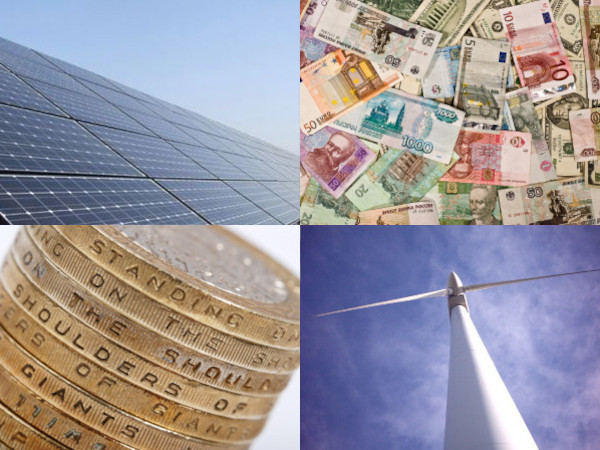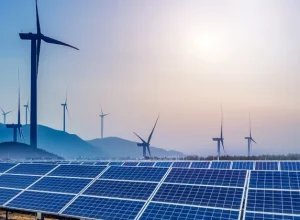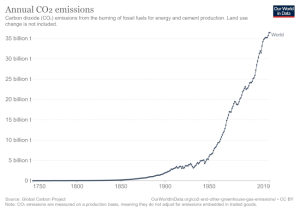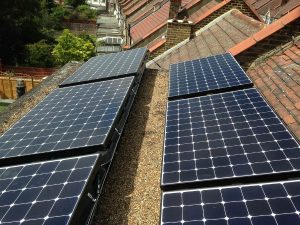This is the first of a two-part conversation, about whether we can transition to renewable energy within the current system, or whether we need system change. Here, guest author Marcos Otero Vega argues that we can’t run a high-tech, capitalist society on renewables, and therefore we have to talk about system change. Next week, another guest author, Ben Dunn Flores, presents a different perspective. We think this is a crucial debate, and we’d love to hear your thoughts in the comments below.
I’ll start the conversation with this bold statement. There will not be an energy transition to renewables. At least not the way it’s being advertised by the neoliberal left.
There will be a transition though… to a world with a lot less energy, fossil or renewable. Let’s start with fossil energy. The exponential growth in the use of fossil fuels in the last 50 years or so has led to peak oil. The world is on a downward trend in its capacity to extract oil from the crust of the earth. This is not to say that oil is running out. There are considerable reserves worldwide, but all the large oil fields where oil is easily extracted with relatively low energy inputs are in decline. New fields are not being discovered at the rate at which the old ones are declining. Moreover, the extraction of oil is becoming harder, for example from deeper fields at huge depths under the ocean floor. The quality of the new fields is also lower, like the tar sands of Canada or the heavy oil in the Orinoco basin in Venezuela. This means that the energy return from this oil is significantly reduced, which means that more and more energy is needed to extract the same amount of oil. So, if you need to invest the energy equivalent of 20% of an oil barrel to extract one oil barrel, then you don’t have an oil barrel… you have 80% of an oil barrel. As the energy return decreases, many fields will not be exploited simply because they will become uneconomical – too hard to extract. The image below illustrates this point. We are at the tight oil, oil sands and biofuels point.

The Energy Return on Energy Invested (ERoEI) is a fundamental concept to understand because it defines the viability of a resource. Clearly, when ERoEI = 1, there is no point in exploiting such a resource because you’re investing as much energy as you obtain from it. However, an energy source can become uneconomical much before it reaches an ERoEI of 1. Indeed, modern society, with its huge energy requirements, needs a much higher ERoEI to function properly. See the graph below, developed by a number of analysts at The Oil Drum:

By the time an energy source reaches an ERoEI of 11:1, the functioning of a hyper-complex, technology-based industrial society becomes unviable.
When oil extraction first started and ‘oil gushers’ were common, ERoEI for oil was an extraordinary 500:1. In the 1900-1930 era, ERoEI for oil was still 100:1. In 1970, ERoEI for oil was approximately 30:1. In 2019, oil and gas ranged between 10:1 and 20:1, with the occasional study reporting 65:1 (Michaux, 2021).
Current ERoEI of oil is dependent on individual fields, with the large fields in South Arabia having a much higher ERoEI than the tar sands of Canada or the deep-water fields off Brazil.
All the above was intended to explain the point that oil and fossil fuels in general will become scarce, expensive and unable to meet the growing global demand. This will translate into higher prices and economic decline, which in turn will impact the economic viability of mass production of solar panels, wind turbines and other renewable energy applications such as batteries, which require industrial outputs highly dependent on cheap oil being available for its production (think mining and processing of metals which can only be done with fossil fuels). This has started to become apparent in the past couple of years. All major wind turbine manufacturers (Siemens, Vestas, GE) have reported huge losses and closed factories in many countries, including Germany, France and Spain. This is a direct consequence of higher oil prices that have made all the raw materials needed for the production and installation of wind turbines more expensive. From cement to copper, iron to logistics, throughout the production chain, an increase in the price of oil has impacted the viability of many renewable energy projects, many of which are only viable with strong financial support (subsidies) from governments. See below some news taken from a recent article in The New York Times.
Siemens Gamesa Renewable Energy, a Madrid-based company that is the premier maker of offshore wind turbines, reported an annual loss of 940 million euros ($965 million).
Vestas Wind Systems, the world’s largest maker of turbines, recently reported a loss of 147 million euros (about $151 million) for the third quarter.
General Electric, a large maker of wind turbines in the United States and Europe, has also struggled in its clean energy businesses. The company said last month that its renewable energy unit was likely to record $2 billion in losses this year.
Let’s talk renewables
Energy sources such as solar, wind or water are all technically renewable. To harvest energy from these sources requires wind turbines, solar panels, and water turbines. To store this energy so it can be used in transport applications requires batteries. Each of these units require manufacture and non-renewable finite mineral resources. Each of these units has a working life of approximately 10 to 20 years (with the exception of hydro), after which they need to be decommissioned and replaced with new units. This means the non-fossil fuel systems are not really renewable at all but are in fact better described as ‘replaceable’ (Hagens 2021; Michaux, 2021). Current recyclability of these systems is very low. On solar panels it’s limited to the aluminium frame and glass. On wind turbines only some metals are recycled, but not the concrete footing (off-shore) or the fibreglass in the blades.
The production, transport, installation, maintenance and final decommissioning, recycling and disposal of the spent systems all rely on fossil fuels at every step of the process. This is unlikely to change in the near future. Let’s look at some numbers, on the graph below, from the International Energy Agency (IEA). On the left, the graph shows how the various low-carbon energy technologies need to grow under various scenarios. The only scenario of interest to keep global warming below 1.5 °C is the last one, Net Zero Emissions (NZE), which requires the highest increase in clean energy deployment. The graph on the right shows the minerals and metals required for the implementation of each scenario. Again, the NZE scenario requires the highest amount of materials.

From the IEA:
The total installed capacity of renewables triples to 2030 and rises sevenfold to 2050. Annual renewables capacity additions quadruple from 290 GW in 2021 to nearly 1 200 GW in 2030, and average above 1 050 GW from 2031 to 2050.
These numbers are not only astonishing, but highly unrealistic. It has taken the last twenty years or so to get to the current level of renewables, yet the world needs to multiply that by four in the next seven years! An even steeper increase would be required from 2030 to 2050 to achieve the NZE objectives. The IEA report continues, specifically addressing solar PV and wind:
Solar PV additions expand more than fourfold to 650 GW by 2030, and wind additions to over 400 GW.
Lets look in more detail at the promising technology of solar PV.
The graph below is also highly revealing regarding the impossibility of the energy transition to renewable energy. It’s only about solar panels – growth from 2021 to 2030 (a mere 9 years) and the associated critical minerals that need to be extracted and processed to feed this expansion. This is in addition to other industrial uses that those same minerals may be required for, including other renewables, general electrification of industries, etc. The graphs are quite revealing by themselves, but actually it gets more interesting when you do the maths and calculate the % increase on critical minerals required. Copper demand would increase from 500 kt to 2000 kt, a 400% increase. Silicon – which although abundant, uses large amounts of energy (coal) for its processing from silica – would see similar growth. Silver increases by 320%, Zinc, by 400%. Other critical minerals, which refers mostly to the so-called rare-earth minerals, would increase by 440%; so they will have to, somehow, stop being rare and suddenly become abundant.
And remember, this is just solar energy from 2021 to 2030, less than halfway to the 2050 net zero emissions roadmap!

Now, speak to any geologist and ask them if they think that the world can increase by 400% its production of all those minerals before 2030. In fact, the question is not whether the production capacity can be increased, the question is whether there is enough of those minerals within the earth’s crust, or at least whether there’s enough at concentrations at which it’s financially and energetically viable to extract such volumes. There isn’t. But even if I’m wrong, can the earth cope with the proposed level of mining, crushing, refining, transporting, etc. of those minerals? How many toxic chemicals would be required to leach those metals from their ores? How many forests removed to make way for huge open mines?
And let’s not forget, the mineral industry has for the past 50 years concentrated on extracting minerals from those locations where concentrations were highest and most accessible. The world has been searched for those resources and areas of high yield potential have been mined. What’s left now are the currently open mining operations – many of which are being exhausted – and other areas with lower concentrations, where a lot more rock needs to be processed at huge energy costs, to extract lower amounts of those metals and minerals.
One of the most knowledgeable people in the field of geology and mining is Simon P. Michaux, Associate Professor of Geometallurgy, from the Geological Survey of Finland, with a PhD in mining engineering. He’s produced many reports and studies looking at the interactions between fossil fuels, energy, renewables and minerals. In one if his most recent reports (Michaux, 2021) he concludes:
This report suggests that replacing the existing fossil fuel powered system (oil, gas, and coal), using renewable technologies, such as solar panels or wind turbines, will not be possible for the entire global human population. There is simply just not enough time, nor resources to do this by the current target set by the World’s most influential nations.
Michaux’s report is a 1,000-page compilation of data and analysis on all aspects of energy use and mineral resources. Too long to go into much detail here, but let’s see a graph from his analysis on the minerals and metals needed to electrify the global fleet of vehicles using Lithium batteries:

The graph shows how most metals/minerals needed for the production of the required battery storage far exceeds global reserves. Moreover, the report notes that this is only the quantities required to produce the first generation of batteries to replace the fleet of internal combustion engine cars. With an expected lifetime of about 10 years, the same volumes would be required every 10 years! Of course, some of these metals and minerals could be recycled from spent batteries, but that would have to be with yet undeveloped technology, because currently recycling of most of the components of batteries is either not feasible or uneconomic. Even if those technologies were to be developed, large volumes of metals and minerals would still need to be mined because recycling is an inefficient process, which often results in downcycling. Currently hardly any car batteries are recycled.
The report also rules out the use of biofuels. In his analysis, Michaux concludes not only that the ERoEI of biofuels is very low, (from algae it’s probably negative), something that ecologist have been claiming for a long time. But he also concludes that in a scenario where some of the current uses of petroleum products which are hard to electrify (aviation, maritime transport, iron smelting, HGV vehicles, etc.) were to be replaced by biofuels sourced from soybean or corn feedstock, the arable land required to grow enough biomass would far exceed the current global land used for food production. That, in a context of changing climate, water scarcity, increase desertification, soil degradation, increased fertilizer costs and growing global demand for food as a result of population growth. Such a scenario can, therefore, be completely discarded.
The report includes similar calculations and projections for scenarios in which hydrogen is used for HGV vehicles and other industrial applications that are difficult to electrify. Again here, the extremely inefficient production of “green hydrogen” through electrolysis makes it an impossible task, because the additional renewable energy capacity to produce this hydrogen is completely disproportionate, as that capacity needs to be added on top of the required deployment to electrify other parts of the economy.
Conclusion
The current level of energy usage cannot be maintained, be it with fossil fuels or renewable energy. The only solution is a steep decline in the global energy per capita usage. This is particularly the case for the developed world.
Such a decline in energy consumption is unlikely to be able to maintain the current capitalist economic system or even society as we currently know it. The complexities of a highly technological society require levels of energy and material inputs that will simply not be available in the near future.
We will have to adapt and transition to a less energy-intensive society.
This outcome was quite accurately predicted by a team of scientists from the Massachusetts Institute of Technology (MIT) back in the 1970s. Their report, The Limits To Growth was based on a computer model that predicted that levels of resource usage, pollution and population exponential growth would lead to the collapse of modern society. The graph below is the most familiar, but the report contains many more detailed explanations of how they reached their conclusions. Fifty years later, the report remains chillingly relevant.

Next week, another guest author – Ben Dunn Flores – will present an alternative perspective.













22 Comments
There’s a strong connection between this article and last week’s on degrowth vs green growth: https://www.lowimpact.org/posts/degrowth-or-green-growth
Nation-states can’t find a way to reach net zero emissions (indeed, 27 years of COP meetings have culminated in record global carbon emissions), because they are committed to perpetual, endless, eternal and constant GDP growth. Suggesting that maybe globally, we reduce energy use, flights, cars, production, consumption etc. can never be discussed at the state level because it clashes with this quest for endless growth and the short-term focus of governments on winning the next election and it would require more shrinkage in the powerful, rich countries – which is why government plans for net zero emissions remain pure fantasy.
The solution is not coming and cannot come via the state. We need to give up on that idea asap I think.
There’s a strong connection between this article and last week’s on degrowth vs green growth: https://www.lowimpact.org/posts/degrowth-or-green-growth
Nation-states can’t find a way to reach net zero emissions (indeed, 27 years of COP meetings have culminated in record global carbon emissions), because they are committed to perpetual, endless, eternal and constant GDP growth. Suggesting that maybe globally, we reduce energy use, flights, cars, production, consumption etc. can never be discussed at the state level because it clashes with this quest for endless growth and the short-term focus of governments on winning the next election and it would require more shrinkage in the powerful, rich countries – which is why government plans for net zero emissions remain pure fantasy.
The solution is not coming and cannot come via the state. We need to give up on that idea asap I think.
A very interesting article Marcos, thank you.
I very much agree with your comments also Dave. We really do just have to concentrate on the positive things that are being done around the world (and there are many), including the excellent drive via this website and elsewhere for a new economy via the credit commons etc.
As has been said before we must grow the new system in the cracks of capitalism/industrialised society. More positivity less finger wagging, even although articles such as these are so important.
Keep up the good work.
I agree with much of your article, Marcos.
However, I’m not sure the overall conclusion is justified.
For example, a lot hinges on the implications of diminishing overall EROI of our aggregate global human economy. What is the threshold for a thriving human society? Uncertainty ranges? What average aggregate EROI will we experience as we transition to a decarbonised global economy? Uncertainty ranges on that also?
You cite the work of Simon Michaux on challenges in materials supply chains, based largely on existing energy generation, transmission and storage tech . But that doesn’t fully take into account some promising developments on, for example, battery technologies, as communicated by Simon Moores and others, which could go at least some way to solving supply chain bottlenecks.
If we succeed in moving away from current dominance of GDP as a metric of economic success, then a combination of ‘natural’ demographic trends in population size, decoupling of wellbeing from such material throughputs, circular economy and keeping within planetary boundaries, as per Rockstrom, Steffen, Raworth and others might get us through.
These things haven’t been properly tried yet. I wouldn’t give up on them yet.
These comments, and the article, are also published at:
https://www.linkedin.com/posts/marcos-otero-vega-mciwm-91a72733_no-renewables-transition-activity-7046171441678925824-6BqI?utm_source=share&utm_medium=member_desktop
Hi David, I just did a quick search for Simon Moores & battery technologies, & it looks like he uses lithium. It’s tricky to know how we will get enough lithium to enable this as a viable option. Is there something that I’m not realising?
I know I may seem a little naive here – but I suspect we are missing out a vital variable – that of human ingenuity. We have to do this – and therefore, eventually we will. I’m halfway through an MSc and am looking at future renewables, and the technology is changing all the time. Whether it’s the capacity, the materials used, or the recycleability of the technology. There are a number of both big and small players in the tech who are only too aware of the problem and are looking at alternatives – the bigger grid-connected batteries, different materials, or aiming to make the grid itself more stable, which would reduce the need for homeowner based batteries.
There is no denying that we have to be very aware of these difficulties – especially around the use, or reuse, of steel. But we also have to make sure we don’t play right into the hands of the fossil fuel money. So much money is STILL pumped into those companies whilst renewables are seen as too ‘risky’ – that is changing, but it is not changing fast enough – much of what we have achieved in the last twenty years seemed impossible 50 years ago. It’s moving fast. The latest call for marine renewables trials (which are successful) are deliberately looking at a low maintenance (every 25 yr) lifespan and recyclable expectations of all materials built into the demands.
I’m not saying we will be able to completely cease all dependence on fossil fuels -or that we can expect a full degrowth agenda to fulfil what we need (see the degrowth / green growth post) – but we can reduce our dependance on it drastically, and there are lots of studies that show that once communities start taking responsibilty for their energy production, they also reduce their useage. And this is very important. We have to start somewhere, right?
Man can create a society in which he can live indefinitely on earth if he imposes limits on himself and his production of material goods to achieve a state of global equilibrium with population and production in carefully selected balance.
https://cen.acs.org/energy/renewables/Recycling-renewables/96/i15 – Recycling renewables: Can we close the loop on old batteries, wind turbines, and solar panels to keep valuable materials out of the trash?
https://doi.org/10.1016/j.ensm.2019.11.003 – Dual-ion batteries: The emerging alternative rechargeable batteries
https://doi.org/10.1016/j.jclepro.2014.04.035 : Exploring rare earths supply constraints for the emerging clean energy technologies and the role of recycling
European Marine Energy Centre: https://www.emec.org.uk/about-us/emec-history/
https://www.tatasteeleurope.com/sustainability/circular-economy – The future is Circular
Thanks for sharing your research Rebecca, it’s really inspiring to hear that there are some great minds at play!
Rebecca
That’s a really important issue – but it’s the ‘within the current economy’ part that’s crucial, I think.
And the current economy (let’s call it ‘capitalism’, although some have a problem with this. In the same way that many old commies say that the Soviet Union wasn’t communism – and they were right – many say that the current economy isn’t capitalism, because it doesn’t involve free markets – markets are skewed by states in favour of giant corporations) involves perpetual GDP growth – it has a growth imperative, in other words.
There are several aspects to this:
1. the impossibility of infinite growth on a finite planet. Capitalists argue against this, but it’s pretty clear. The human economy is destroying the biosphere, so a bigger human economy will destroy it faster. And GDP growth can’t be ‘dematerialised, because growth increases spending power, which there’s no way to ring-fence so that it’s not spent on material things. And it is spent on material things. So a larger per capita GDP means more flights, more cars, more clothes, more furniture, more electrical goods, more computer games, more fridges etc. etc. This is the case, in the real world – it’s not a hypothesis.
If people think that GDP growth can continue forever, that’s where the difference lies, not with any technology.
2. ‘Capitalism’ also concentrates wealth perpetually. This will prevent real democracy and ensure that the status quo is maintained. So the destruction of the biosphere is locked in with this economy.
3. If we had a commons economy, or another kind of economy that didn’t have to permanently grow, and didn’t concentrate wealth, then maybe it could run on renewables. But not this one.
4. Technology got us into this mess. The steam engine, the internal combustion engine, power stations, shipping, concrete, etc. etc. James Watt’s engine was designed to save coal (because it was so much more efficient). But he didn’t know about Jevon’s Paradox, and the fact that efficiency measures always increase the use of a resource. So even though the new technology was more efficient, thousands of times more coal was used after its invention, because it helped GDP to grow faster. Exactly the same would happen now if nuclear fusion comes on stream. It will make GDP grow faster and accelerate biosphere destruction. That’s always the case with new tech – which is why corporations are at the cutting edge of it. Money, money, money. Now tech a tool of capitalists, and causes more problems than it solves – because the main point of it in this economy is making profit. Technology isn’t going to solve the problems it caused. It can’t, in this economy.
5. Human ingenuity is great – but it can’t design technology that can allow GDP to grow forever, any more than it can design a perpetual motion machine – because neither is possible. You hear ‘humans are an incredible species’. We can go to the stars etc. I agree. But right now, that’s not the thing to focus on. We need to be wise, not just ‘ingenious’. And the wise thing to do is to not destroy the biosphere of the only planet we know for sure has one – with fresh water, breathable air, fertile soil and the right temperature range – all of which we’re changing – in the wrong way.
6. Sure, there has been lots of ingenuity in designing tech that makes money. But 27 years of COP meetings have culminated in record carbon emissions and record biodiversity loss. We don’t seem to be ingenious enough to solve those problems (because they don’t have technical solutions).
7. Technology may soon be (and maybe already is) out of our control. With the people we have in positions of power, and this system in place, that will be a disaster that may finish us (as weaponry, AI, genetic engineering, nanotech etc. develop much faster than most of us can keep up with). We have to get good governance, which means bringing production into the commons, before we can experiment with other ways to relate to each other than competition and war.
8. Kevin Carson says: “scientific discoveries can be useful in at least two opposite ways. The first leads to specialization of functions, institutionalization of values and centralization of power and turns people into the accessories of bureaucracies or machines. The second enlarges the range of each person’s competence, control, and initiative, limited only by other individuals’ claims to an equal range of power and freedom”. Modern tech is developing in the first way, and is therefore very destructive and dangerous.
9. I think the split between those who believe that ‘progress’ (via human ingenuity) will be our saviour and those who believe that this quest for perpetual progress and techno-utopianism will be our downfall is much more important than the defunct left/right split. And the ‘progressive’ / ecomodernist approach always equates increased consumption with greater well-being, which is patently untrue. Increased consumption, after it has passed a line of meeting basic needs, quickly collapses into a world of stupidity, obesity, boring work, environmental destruction, ugliness, materialism and away from health, community, spirituality, intelligence – the true markers of well-being.
OK, so that’s a blog article rather than a comment!
Hi,
Yes, I think it is important that when we think of technology saving us we need to be aware of the IPAT equation where: I = P X A X T
I = ecological impact
P = Population
A = Affluence
T = Technology
This also brings into focus the difference between the 1st and 3rd worlds where although the 3rd world have lots of people/large populations their effect is far less than the developed world as their technology and affluence is far less. So far from being a saviour technology, and the affluence it often drives, can actually be a large driver of ecological destruction and hence can bring us closer to our collapse. Also, as already allured to and to paraphrase Einstein ‘ we cant use the same ideas that got us into a predicament to get us out of it’.
Excellent debate though!
Malcolm
“technology, and the affluence it often drives”
Agreed, excessive affluence is the problem. But go deeper, and the problem is capitalism (or whatever you want to call the actually-existing economy), which is all about growth and making money from money. In a different system – one that doesn’t concentrate wealth, doesn’t have to grow forever, and doesn’t bombard us with advertising, because a fall in overall consumption means recession.
Yes, good debate. But Part 2 is coming. This grew out of a heated debate in a Telegram channel I’m in. Someone is sending a second article, with a different viewpoint. At least I hope so – we’ve been promised it. Fingers crossed.
I did not read the article (sorry) but all I can say is, of course we need system change.
Dave Darby, you say “If we had a commons economy, or another kind of economy that didn’t have to permanently grow, and didn’t concentrate wealth, then maybe it could run on renewables. But not this one.”
I agree, and I think that is very much at the core of this debate, in my view. That’s especially important in the absence of any substantial evidence in our current economy of decoupling of the monetary economy and human wellbeing from material throughput and environmental degradation.
I see there being two main scenarios going forward.
The first one is essentially a continuation of an adapted version of the current combination of government actions and the hidden hand of the markets, an eventual decoupling through technological improvements and melding of ecological economics into the mainstream, inclusion of all environmental externalities into costs and prices, a peaking of global population and crystallisation of a truly circular economy with very little residual “waste” and social welfare and justice implemented through progressive taxation and other government interventions.
The second one gets to a similar place of a just and sustainable future, but in a different sequence, eg through social movements being the drivers of somewhat “revolutionary” shifts in how everything is done. A new economics based not on traditional capitalism but ecological, regenerative society, industrial and financial processes. Reinventing money and the basis of what constitutes “value” and wealth. GDP toppled and replaced with alternative metrics for wellbeing of humans in balance with the rest of nature. “Deep ecology rules” might, perhaps, be a replacement for “Capitalism and GDP rules”?
Any other feasible scenarios for getting to a similar just and sustainable future for all?
I’m in two minds about my “Deep ecology rules” scenario I paint above.
On the one hand, the end-point is a good vision to have for an enduring just and sustainable future for all.
On the other hand, the more drastic and disruptive the path taken from here to there, the greater the chances of such a path being co-opted and corrupted by people who are waiting in the wings and ready to seize power for their own nefarious ends. Situations of relative chaos can let such interests take power. There are numerous examples from history. Just one such would be rise of nationalism (not just a distant historical phenomenon but very topical now). People who purport to be acting in the public’s interest, but who actually have an agenda for creating their own forms of autocracy, often through deliberate acts of “othering”, preying on people’s fears rather than building genuinely on their hopes and dreams.
So, a big issue is how to make desired changes happen, but without creating “the wrong kind of chaos”. Answers on a postcard, please …
David Calver (comment 11)
I agree, those are the two (optimistic) scenarios. There’s another one of course – not so optimistic – that destruction of the biosphere will accelerate and it’s game over. On bad days, I can’t shake the feeling that this is edging closer to inevitable.
But, back to the optimistic scenarios. The first one requires governments that are up for the challenge, capable, and not under the thrall of the corporate sector. Where are those governments? I just can’t see that one happening. Not with the amount of corporate money sloshing around in the political system, and not with governments having to prioritise growth to compete in a global capitalist economy; and not with corporate ownership of the media.
The second one – yay!
David Calver (comment 12)
Doesn’t have to cause chaos. Let’s build the commons economy slowly and deliberately, without violence or dismantling of capitalism / state before there’s commons infrastructure to replace it.
Answer: (not) on a postcard – https://www.lowimpact.org/categories/low-impact-economy
Lots and lots and lots of fine words: some will be doing amazing things in response to the data. Most won’t, and therein lies a massive issue – if not enough ppl are not doing enough, we are chips. But really, why do we care? Isn’t this just good ol’ evolution in action; external environmental pressures over eons causing random mutational changes to pond scum’s DNA expressor proteins whose stepwise internal physiological bingos eventually produce professors? via a load of really nasty ppl doing really really nasty things as we evolved into…really really really nasty.
After that good ol’ big bang of a beginning, the final evolutionary hooraa may look a bit tame in comparison. And are the said rare minerals not still being evolutioned into existence? – surely there have been similar geoenvironmental conditions over the past 18,000,000,000,000,000,000,000 years (could someone tell me if I’ve done enough 0’s?) to enable a continual supply of copper, lithium etc?
On the solar aspect of this – as far as I can make out it’s true that solar available in the UK largely has relatively high embodied carbon – I did a blog on that here – but I don’t think it follows that renewables growth can’t continue at increased rates. It’s by no means necessary for coal to be used to make silicon for solar – the panels we buy partially use silicon produced using hydro. There are also other types of panel which require radically less energy to make and not just in labs – First Solar in the US are a leading producer over there and their thin-film panels are a well established alternative. As solar itself gets better and cheaper it is beginning to be used for serious industrial processes. Wind is already an established supplier of primary energy into the steel industry.
On renewables more widely – I think that it’s often assumed that because renewables are intermittent, you need incredible amounts of energy storage for them to replace fossil fuels – often taken to mean lots of batteries. That’s not quite right in my view. If energy supply becomes more intermittent then there is an incentive for users to profile their demand – an incentive that just does not exist in a fossil-fuel dominated system. For example we are already fitting vehicle chargers that know when it is sunny and try to charge most at those times and more sophisticated versions of this are in the works. In the UK context as we move from oil and gas to heat pumps we add a lot of electric demand which can be similarly flexible – it’s relatively cheap to store heat for a few days. And of course relatively small changes to UK Govt policy could save vast amounts of heat load through better insulation.
Does this mean that we don’t need to question growth or capitalism? I think we do, and that the need is more pressing than ever. But at the same time I am forced to confront the fact that my 30+years of environmental activism have not moved the dial at all on this. I don’t think that system change can be seen as a precondition for technological change any more. For me that’s not so much a softening of my core beliefs but a recognition that our movement has had plenty of time to make the case and it has failed so far. In the very short timescale we have we need to keep the vision of a sustainable and just society in front of us, but if we are to have any chance of averting the very worst of climate change a lot of our work will need to be done within or around the current system.
In the UK context right now there is quite a lot of innovation and delivery being done by pretty conventional corporate actors – it’s actually ideology at Govt level which is holding this back for us at present. On the global scale at this exact moment authoritarianism and populism is probably more of a threat to decisive action on carbon than capitalism.
Can we sort climate change out under capitalism? I don’t know – it seems unlikely doesn’t it! – but I don’t think we have yet built the movement we thought we were building to replace it so at this late hour we’re pretty much strapped in for the ride.
I say this as somebody who has exclusively worked through the co-operative movement for the last 20 years – we can and should still build alternatives but only if they are delivering real-world solutions as we go.
@jon – That blog is really interesting thank you. I don’t want to hijack the conversation here, as it ‘s a bit off topic- but it really does show the difficulty in working out the carbon cost of renewables.
I agree that ideology at govt level is holding us back – and very much like the phrase that we are ‘strapped in for the ride’!
Hi Jon
Sure, we need to (and will) keep developing and installing more and more renewables, but unfortunately, imo, any gains from that will be wiped out by the fact that global GDP keeps growing, and has to, in capitalism.
But your work is all happening in the co-operative world, so not only are you developing renewables, you’re also part of the new economy that will (and will have to) replace capitalism eventually. Building the alternatives is a slow slog, but I hope (and believe) that new ideas emerging in the commons world will speed things up. See https://www.lowimpact.org/categories/commoning/further-info/building-the-commons-economy
If I’m completely honest with myself, every day I get closer to the position of Jem Bendell on the inevitability of societal collapse. As governments are all making the situation worse, by scrambling for GDP growth and flying around the world to totally useless COP meetings, then I don’t see any solution. Of course I’m going to keep trying to build the new commons economy, because we’re going to need community-based safety nets when it all starts to fall over (well, it’s already started, so I guess I mean when it becomes more important to the mainstream than the football results).
https://www.resilience.org/stories/2023-04-10/the-rising-chorus-of-renewable-energy-skeptics/
I understand that mutual credit can be used as a means of exchange for sole traders, but can it be used to pay wages if the creation of a product or service requires a team of people?
Richard – sure. Existing businesses can join mutual credit schemes, and they can pay workers some or even all of their wages in mutual credit if they agree to it. There might be employment law issues in not paying wages in legal tender, but if employees want to be paid in mutual credit, there will be ways to do it. But first there has to be a working mutual credit network that employees can spend their wages in.